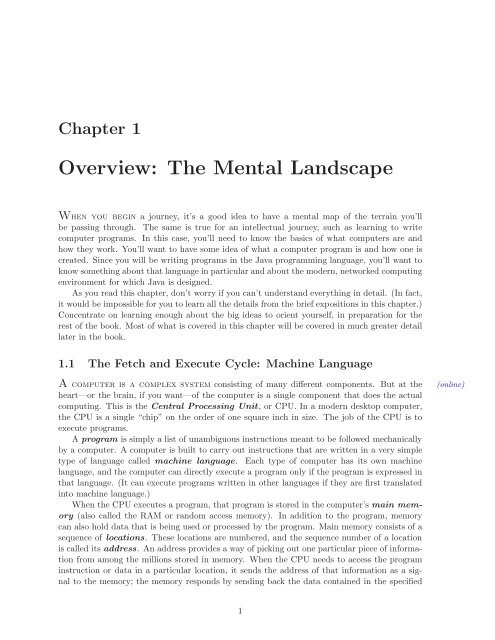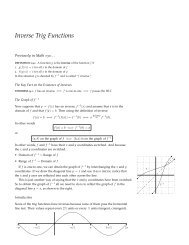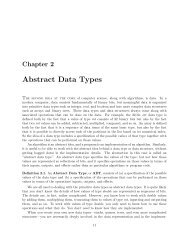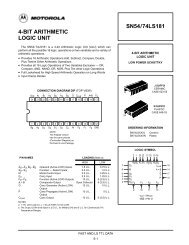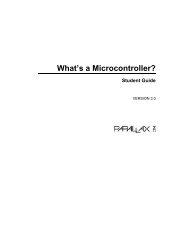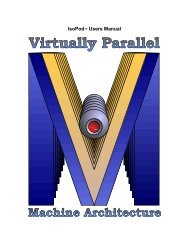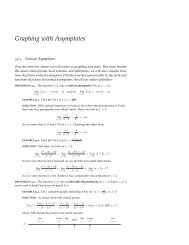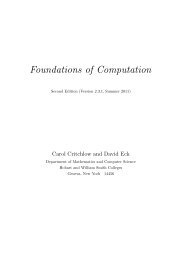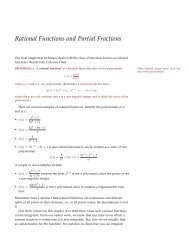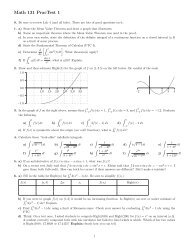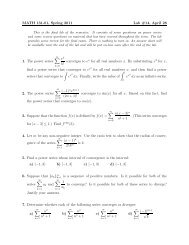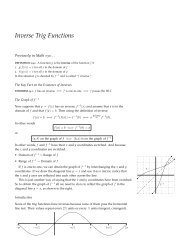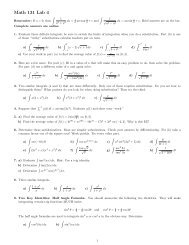- Page 1 and 2: Introduction to Programming Using J
- Page 3 and 4: ContentsPrefacex1 The Mental Landsc
- Page 6 and 7: CONTENTSiv5.5 Inheritance and Polym
- Page 8 and 9: CONTENTSvi7.5 Multi-dimensional Arr
- Page 10 and 11: CONTENTSviii11.1.5 The Scanner Clas
- Page 12 and 13: PrefaceIntroduction to Programming
- Page 16 and 17: CHAPTER 1. THE MENTAL LANDSCAPE 2lo
- Page 18 and 19: CHAPTER 1. THE MENTAL LANDSCAPE 4
- Page 20 and 21: CHAPTER 1. THE MENTAL LANDSCAPE 6mu
- Page 22 and 23: CHAPTER 1. THE MENTAL LANDSCAPE 8
- Page 24 and 25: CHAPTER 1. THE MENTAL LANDSCAPE 10p
- Page 26 and 27: DrawableObjectTwoPointObject Multip
- Page 28 and 29: JComponentJAbstractButton JComboBox
- Page 30 and 31: CHAPTER 1. THE MENTAL LANDSCAPE 16i
- Page 32 and 33: Chapter 2Programming in the Small I
- Page 34 and 35: CHAPTER 2. NAMES AND THINGS 20now:/
- Page 36 and 37: CHAPTER 2. NAMES AND THINGS 22No sp
- Page 38 and 39: CHAPTER 2. NAMES AND THINGS 24Any d
- Page 40 and 41: CHAPTER 2. NAMES AND THINGS 262.2.3
- Page 42 and 43: CHAPTER 2. NAMES AND THINGS 282.3.1
- Page 44 and 45: CHAPTER 2. NAMES AND THINGS 30lengt
- Page 46 and 47: CHAPTER 2. NAMES AND THINGS 32Then
- Page 48: CHAPTER 2. NAMES AND THINGS 34An en
- Page 51 and 52: CHAPTER 2. NAMES AND THINGS 37When
- Page 53 and 54: CHAPTER 2. NAMES AND THINGS 39than
- Page 55 and 56: CHAPTER 2. NAMES AND THINGS 41are t
- Page 57 and 58: CHAPTER 2. NAMES AND THINGS 43}}Str
- Page 59 and 60: CHAPTER 2. NAMES AND THINGS 45For e
- Page 61 and 62: CHAPTER 2. NAMES AND THINGS 47Suppo
- Page 63 and 64: CHAPTER 2. NAMES AND THINGS 492.5.7
- Page 65 and 66:
CHAPTER 2. NAMES AND THINGS 512.6.2
- Page 67 and 68:
CHAPTER 2. NAMES AND THINGS 532.6.3
- Page 69 and 70:
CHAPTER 2. NAMES AND THINGS 55error
- Page 71 and 72:
Exercises 57Exercises for Chapter 2
- Page 73 and 74:
Quiz 59Quiz on Chapter 2(answers)1.
- Page 75 and 76:
CHAPTER 3. CONTROL 61That is, it co
- Page 77 and 78:
CHAPTER 3. CONTROL 63public class I
- Page 79 and 80:
CHAPTER 3. CONTROL 65System.out.pri
- Page 81 and 82:
CHAPTER 3. CONTROL 67time we proces
- Page 83 and 84:
CHAPTER 3. CONTROL 69In order to co
- Page 85 and 86:
CHAPTER 3. CONTROL 71TextIO.putln(N
- Page 87 and 88:
CHAPTER 3. CONTROL 73that were intr
- Page 89 and 90:
CHAPTER 3. CONTROL 75count = 0;/* R
- Page 91 and 92:
CHAPTER 3. CONTROL 77Similarly,〈d
- Page 93 and 94:
CHAPTER 3. CONTROL 793.4.1 For Loop
- Page 95 and 96:
CHAPTER 3. CONTROL 81(1) // There a
- Page 97 and 98:
CHAPTER 3. CONTROL 83Finally, we ca
- Page 99 and 100:
CHAPTER 3. CONTROL 85}System.out.pr
- Page 101 and 102:
CHAPTER 3. CONTROL 87The enhanced f
- Page 103 and 104:
CHAPTER 3. CONTROL 89if (〈boolean
- Page 105 and 106:
CHAPTER 3. CONTROL 91}System.out.pr
- Page 107 and 108:
CHAPTER 3. CONTROL 93TextIO.putln("
- Page 109 and 110:
CHAPTER 3. CONTROL 95Why? Because t
- Page 111 and 112:
CHAPTER 3. CONTROL 97TextIO.putln("
- Page 113 and 114:
CHAPTER 3. CONTROL 99to replace the
- Page 115 and 116:
CHAPTER 3. CONTROL 101As an example
- Page 117 and 118:
CHAPTER 3. CONTROL 103}}count = 0;t
- Page 119 and 120:
CHAPTER 3. CONTROL 105of the class)
- Page 121 and 122:
CHAPTER 3. CONTROL 107rectHeight =
- Page 123 and 124:
CHAPTER 3. CONTROL 109height = getH
- Page 125 and 126:
Exercises 1115. Suppose that a file
- Page 127 and 128:
Quiz 113Quiz on Chapter 31. What is
- Page 129 and 130:
Chapter 4Programming in the Large I
- Page 131 and 132:
CHAPTER 4. SUBROUTINES 117The contr
- Page 133 and 134:
CHAPTER 4. SUBROUTINES 119}// param
- Page 135 and 136:
CHAPTER 4. SUBROUTINES 121Tell the
- Page 137 and 138:
CHAPTER 4. SUBROUTINES 123distingui
- Page 139 and 140:
CHAPTER 4. SUBROUTINES 125TextIO.pu
- Page 141 and 142:
CHAPTER 4. SUBROUTINES 127A formal
- Page 143 and 144:
CHAPTER 4. SUBROUTINES 129break the
- Page 145 and 146:
CHAPTER 4. SUBROUTINES 131parameter
- Page 147 and 148:
CHAPTER 4. SUBROUTINES 133return ty
- Page 149 and 150:
CHAPTER 4. SUBROUTINES 135return
- Page 151 and 152:
CHAPTER 4. SUBROUTINES 137* startin
- Page 153 and 154:
CHAPTER 4. SUBROUTINES 139The Java
- Page 155 and 156:
CHAPTER 4. SUBROUTINES 141line come
- Page 157 and 158:
CHAPTER 4. SUBROUTINES 143comments
- Page 159 and 160:
CHAPTER 4. SUBROUTINES 145of the su
- Page 161 and 162:
CHAPTER 4. SUBROUTINES 147* Inserts
- Page 163 and 164:
CHAPTER 4. SUBROUTINES 149}mosaic.s
- Page 165 and 166:
CHAPTER 4. SUBROUTINES 151Mosaic.se
- Page 167 and 168:
CHAPTER 4. SUBROUTINES 153}.. // Mo
- Page 169 and 170:
CHAPTER 4. SUBROUTINES 155final sta
- Page 171 and 172:
CHAPTER 4. SUBROUTINES 157.. // Mor
- Page 173 and 174:
Exercises 159Exercises for Chapter
- Page 175 and 176:
Exercises 161will call Mosaic.setCo
- Page 177 and 178:
Chapter 5Programming in the Large I
- Page 179 and 180:
CHAPTER 5. OBJECTS AND CLASSES 165a
- Page 181 and 182:
CHAPTER 5. OBJECTS AND CLASSES 167b
- Page 183 and 184:
CHAPTER 5. OBJECTS AND CLASSES 169i
- Page 185 and 186:
CHAPTER 5. OBJECTS AND CLASSES 171p
- Page 187 and 188:
CHAPTER 5. OBJECTS AND CLASSES 173t
- Page 189 and 190:
CHAPTER 5. OBJECTS AND CLASSES 175c
- Page 191 and 192:
CHAPTER 5. OBJECTS AND CLASSES 1775
- Page 193 and 194:
CHAPTER 5. OBJECTS AND CLASSES 179M
- Page 195 and 196:
CHAPTER 5. OBJECTS AND CLASSES 181s
- Page 197 and 198:
CHAPTER 5. OBJECTS AND CLASSES 183a
- Page 199 and 200:
CHAPTER 5. OBJECTS AND CLASSES 185p
- Page 201 and 202:
CHAPTER 5. OBJECTS AND CLASSES 187*
- Page 203 and 204:
CHAPTER 5. OBJECTS AND CLASSES 189*
- Page 205 and 206:
CHAPTER 5. OBJECTS AND CLASSES 191T
- Page 207 and 208:
CHAPTER 5. OBJECTS AND CLASSES 193p
- Page 209 and 210:
CHAPTER 5. OBJECTS AND CLASSES 195I
- Page 211 and 212:
CHAPTER 5. OBJECTS AND CLASSES 197A
- Page 213 and 214:
CHAPTER 5. OBJECTS AND CLASSES 199}
- Page 215 and 216:
CHAPTER 5. OBJECTS AND CLASSES 201e
- Page 217 and 218:
CHAPTER 5. OBJECTS AND CLASSES 203t
- Page 219:
CHAPTER 5. OBJECTS AND CLASSES 205x
- Page 222 and 223:
CHAPTER 5. OBJECTS AND CLASSES 208S
- Page 224 and 225:
CHAPTER 5. OBJECTS AND CLASSES 210l
- Page 226 and 227:
CHAPTER 5. OBJECTS AND CLASSES 212n
- Page 228 and 229:
CHAPTER 5. OBJECTS AND CLASSES 214}
- Page 230 and 231:
CHAPTER 5. OBJECTS AND CLASSES 216A
- Page 232 and 233:
Exercises 218Exercises for Chapter
- Page 234 and 235:
Exercises 220which means to add ano
- Page 236 and 237:
Quiz 222Counter headCount, tailCoun
- Page 238 and 239:
CHAPTER 6. INTRODUCTION TO GUI PROG
- Page 240 and 241:
CHAPTER 6. INTRODUCTION TO GUI PROG
- Page 242 and 243:
CHAPTER 6. INTRODUCTION TO GUI PROG
- Page 244 and 245:
CHAPTER 6. INTRODUCTION TO GUI PROG
- Page 246 and 247:
CHAPTER 6. INTRODUCTION TO GUI PROG
- Page 248 and 249:
CHAPTER 6. INTRODUCTION TO GUI PROG
- Page 250 and 251:
CHAPTER 6. INTRODUCTION TO GUI PROG
- Page 252 and 253:
CHAPTER 6. INTRODUCTION TO GUI PROG
- Page 254 and 255:
CHAPTER 6. INTRODUCTION TO GUI PROG
- Page 256 and 257:
CHAPTER 6. INTRODUCTION TO GUI PROG
- Page 258 and 259:
CHAPTER 6. INTRODUCTION TO GUI PROG
- Page 260 and 261:
CHAPTER 6. INTRODUCTION TO GUI PROG
- Page 262 and 263:
CHAPTER 6. INTRODUCTION TO GUI PROG
- Page 264 and 265:
CHAPTER 6. INTRODUCTION TO GUI PROG
- Page 266 and 267:
CHAPTER 6. INTRODUCTION TO GUI PROG
- Page 268 and 269:
CHAPTER 6. INTRODUCTION TO GUI PROG
- Page 270 and 271:
CHAPTER 6. INTRODUCTION TO GUI PROG
- Page 272 and 273:
CHAPTER 6. INTRODUCTION TO GUI PROG
- Page 274 and 275:
CHAPTER 6. INTRODUCTION TO GUI PROG
- Page 276 and 277:
CHAPTER 6. INTRODUCTION TO GUI PROG
- Page 278 and 279:
CHAPTER 6. INTRODUCTION TO GUI PROG
- Page 280 and 281:
CHAPTER 6. INTRODUCTION TO GUI PROG
- Page 282 and 283:
CHAPTER 6. INTRODUCTION TO GUI PROG
- Page 284 and 285:
CHAPTER 6. INTRODUCTION TO GUI PROG
- Page 286 and 287:
CHAPTER 6. INTRODUCTION TO GUI PROG
- Page 288 and 289:
CHAPTER 6. INTRODUCTION TO GUI PROG
- Page 290 and 291:
CHAPTER 6. INTRODUCTION TO GUI PROG
- Page 292 and 293:
CHAPTER 6. INTRODUCTION TO GUI PROG
- Page 294 and 295:
CHAPTER 6. INTRODUCTION TO GUI PROG
- Page 296 and 297:
CHAPTER 6. INTRODUCTION TO GUI PROG
- Page 298 and 299:
CHAPTER 6. INTRODUCTION TO GUI PROG
- Page 300 and 301:
CHAPTER 6. INTRODUCTION TO GUI PROG
- Page 302 and 303:
CHAPTER 6. INTRODUCTION TO GUI PROG
- Page 304 and 305:
CHAPTER 6. INTRODUCTION TO GUI PROG
- Page 306 and 307:
CHAPTER 6. INTRODUCTION TO GUI PROG
- Page 308 and 309:
CHAPTER 6. INTRODUCTION TO GUI PROG
- Page 310 and 311:
CHAPTER 6. INTRODUCTION TO GUI PROG
- Page 312 and 313:
CHAPTER 6. INTRODUCTION TO GUI PROG
- Page 314 and 315:
CHAPTER 6. INTRODUCTION TO GUI PROG
- Page 316 and 317:
CHAPTER 6. INTRODUCTION TO GUI PROG
- Page 318 and 319:
Exercises 304Exercises for Chapter
- Page 320 and 321:
Exercises 3068. Write a panel with
- Page 322 and 323:
Exercises 308
- Page 324 and 325:
Quiz 31011. Explain how Timers are
- Page 326 and 327:
CHAPTER 7. ARRAYS 312}int id number
- Page 328 and 329:
CHAPTER 7. ARRAYS 314Note that the
- Page 330 and 331:
CHAPTER 7. ARRAYS 316int[] primes =
- Page 332 and 333:
CHAPTER 7. ARRAYS 318(There is one
- Page 334 and 335:
CHAPTER 7. ARRAYS 320}return null;d
- Page 336 and 337:
CHAPTER 7. ARRAYS 322} // end birth
- Page 338 and 339:
CHAPTER 7. ARRAYS 324public void pa
- Page 340 and 341:
CHAPTER 7. ARRAYS 326variable arity
- Page 342 and 343:
CHAPTER 7. ARRAYS 328order. (This i
- Page 344 and 345:
shapes.length shapes[0] shapesCHAPT
- Page 346 and 347:
CHAPTER 7. ARRAYS 332*/public int g
- Page 348 and 349:
CHAPTER 7. ARRAYS 334• list.size(
- Page 350 and 351:
CHAPTER 7. ARRAYS 336If g is a vari
- Page 352 and 353:
CHAPTER 7. ARRAYS 338type ArrayList
- Page 354 and 355:
CHAPTER 7. ARRAYS 340// Draw a line
- Page 356 and 357:
CHAPTER 7. ARRAYS 342* Searches the
- Page 358 and 359:
CHAPTER 7. ARRAYS 344associates a p
- Page 360 and 361:
CHAPTER 7. ARRAYS 346it’s really
- Page 362 and 363:
CHAPTER 7. ARRAYS 348static void se
- Page 364 and 365:
CHAPTER 7. ARRAYS 350}for (int last
- Page 366 and 367:
CHAPTER 7. ARRAYS 352follow the sam
- Page 368 and 369:
CHAPTER 7. ARRAYS 354double totalPr
- Page 370 and 371:
BLACK BLACK BLACK BLACK 1 BLACK BLA
- Page 372 and 373:
CHAPTER 7. ARRAYS 358/*** Return an
- Page 374 and 375:
CHAPTER 7. ARRAYS 360*/private bool
- Page 376 and 377:
Exercises 362Exercises for Chapter
- Page 378 and 379:
Exercises 364If ball is a variable
- Page 380 and 381:
Exercises 366}word += "\’" + Text
- Page 382 and 383:
Quiz 368Quiz on Chapter 7(answers)1
- Page 384 and 385:
Chapter 8Correctness and Robustness
- Page 386 and 387:
CHAPTER 8. CORRECTNESS AND ROBUSTNE
- Page 388 and 389:
CHAPTER 8. CORRECTNESS AND ROBUSTNE
- Page 390 and 391:
CHAPTER 8. CORRECTNESS AND ROBUSTNE
- Page 392 and 393:
CHAPTER 8. CORRECTNESS AND ROBUSTNE
- Page 394 and 395:
CHAPTER 8. CORRECTNESS AND ROBUSTNE
- Page 396 and 397:
CHAPTER 8. CORRECTNESS AND ROBUSTNE
- Page 398 and 399:
Throwable ErrorSocketException EOFE
- Page 400 and 401:
CHAPTER 8. CORRECTNESS AND ROBUSTNE
- Page 402 and 403:
CHAPTER 8. CORRECTNESS AND ROBUSTNE
- Page 404 and 405:
CHAPTER 8. CORRECTNESS AND ROBUSTNE
- Page 406 and 407:
CHAPTER 8. CORRECTNESS AND ROBUSTNE
- Page 408 and 409:
CHAPTER 8. CORRECTNESS AND ROBUSTNE
- Page 410 and 411:
CHAPTER 8. CORRECTNESS AND ROBUSTNE
- Page 412 and 413:
CHAPTER 8. CORRECTNESS AND ROBUSTNE
- Page 414 and 415:
CHAPTER 8. CORRECTNESS AND ROBUSTNE
- Page 416 and 417:
CHAPTER 8. CORRECTNESS AND ROBUSTNE
- Page 418 and 419:
CHAPTER 8. CORRECTNESS AND ROBUSTNE
- Page 420 and 421:
CHAPTER 8. CORRECTNESS AND ROBUSTNE
- Page 422 and 423:
CHAPTER 8. CORRECTNESS AND ROBUSTNE
- Page 424 and 425:
CHAPTER 8. CORRECTNESS AND ROBUSTNE
- Page 426 and 427:
CHAPTER 8. CORRECTNESS AND ROBUSTNE
- Page 428 and 429:
CHAPTER 8. CORRECTNESS AND ROBUSTNE
- Page 430 and 431:
Exercises 416Exercises for Chapter
- Page 432 and 433:
Exercises 418L 50XL 40Write a class
- Page 434 and 435:
Exercises 420number of divisors. No
- Page 436 and 437:
Quiz 422Theincrement() method is sy
- Page 438 and 439:
CHAPTER 9. LINKED DATA STRUCTURES A
- Page 440 and 441:
CHAPTER 9. LINKED DATA STRUCTURES A
- Page 442 and 443:
CHAPTER 9. LINKED DATA STRUCTURES A
- Page 444 and 445:
CHAPTER 9. LINKED DATA STRUCTURES A
- Page 446 and 447:
CHAPTER 9. LINKED DATA STRUCTURES A
- Page 448 and 449:
CHAPTER 9. LINKED DATA STRUCTURES A
- Page 450 and 451:
Whenanobjectcontainsareferencetoano
- Page 452 and 453:
CHAPTER 9. LINKED DATA STRUCTURES A
- Page 454 and 455:
CHAPTER 9. LINKED DATA STRUCTURES A
- Page 456 and 457:
CHAPTER 9. LINKED DATA STRUCTURES A
- Page 458 and 459:
CHAPTER 9. LINKED DATA STRUCTURES A
- Page 460 and 461:
CHAPTER 9. LINKED DATA STRUCTURES A
- Page 462 and 463:
ortheother.The"enqueue"operationadd
- Page 464 and 465:
CHAPTER 9. LINKED DATA STRUCTURES A
- Page 466 and 467:
CHAPTER 9. LINKED DATA STRUCTURES A
- Page 468 and 469:
CHAPTER 9. LINKED DATA STRUCTURES A
- Page 470 and 471:
RootNode412 3 null 56CHAPTER 9. LIN
- Page 472 and 473:
CHAPTER 9. LINKED DATA STRUCTURES A
- Page 474 and 475:
CHAPTER 9. LINKED DATA STRUCTURES A
- Page 476 and 477:
CHAPTER 9. LINKED DATA STRUCTURES A
- Page 478 and 479:
CHAPTER 9. LINKED DATA STRUCTURES A
- Page 480 and 481:
CHAPTER 9. LINKED DATA STRUCTURES A
- Page 482 and 483:
CHAPTER 9. LINKED DATA STRUCTURES A
- Page 484 and 485:
CHAPTER 9. LINKED DATA STRUCTURES A
- Page 486 and 487:
CHAPTER 9. LINKED DATA STRUCTURES A
- Page 488 and 489:
CHAPTER 9. LINKED DATA STRUCTURES A
- Page 490 and 491:
Exercises 476Write a subroutine tha
- Page 492 and 493:
Quiz 478Quiz on Chapter 9(answers)1
- Page 494 and 495:
Chapter 10Generic Programming andCo
- Page 496 and 497:
CHAPTER 10. GENERIC PROGRAMMING AND
- Page 498 and 499:
CHAPTER 10. GENERIC PROGRAMMING AND
- Page 500 and 501:
CHAPTER 10. GENERIC PROGRAMMING AND
- Page 502 and 503:
CHAPTER 10. GENERIC PROGRAMMING AND
- Page 504 and 505:
CHAPTER 10. GENERIC PROGRAMMING AND
- Page 506 and 507:
CHAPTER 10. GENERIC PROGRAMMING AND
- Page 508 and 509:
CHAPTER 10. GENERIC PROGRAMMING AND
- Page 510 and 511:
CHAPTER 10. GENERIC PROGRAMMING AND
- Page 512 and 513:
CHAPTER 10. GENERIC PROGRAMMING AND
- Page 514 and 515:
CHAPTER 10. GENERIC PROGRAMMING AND
- Page 516 and 517:
CHAPTER 10. GENERIC PROGRAMMING AND
- Page 518 and 519:
CHAPTER 10. GENERIC PROGRAMMING AND
- Page 520 and 521:
CHAPTER 10. GENERIC PROGRAMMING AND
- Page 522 and 523:
CHAPTER 10. GENERIC PROGRAMMING AND
- Page 524 and 525:
CHAPTER 10. GENERIC PROGRAMMING AND
- Page 526 and 527:
CHAPTER 10. GENERIC PROGRAMMING AND
- Page 528 and 529:
CHAPTER 10. GENERIC PROGRAMMING AND
- Page 530 and 531:
CHAPTER 10. GENERIC PROGRAMMING AND
- Page 532 and 533:
CHAPTER 10. GENERIC PROGRAMMING AND
- Page 534 and 535:
CHAPTER 10. GENERIC PROGRAMMING AND
- Page 536 and 537:
CHAPTER 10. GENERIC PROGRAMMING AND
- Page 538 and 539:
CHAPTER 10. GENERIC PROGRAMMING AND
- Page 540 and 541:
Exercises 526Exercises for Chapter
- Page 542 and 543:
Exercises 528program WordCount.java
- Page 544 and 545:
Quiz 530Quiz on Chapter 10(answers)
- Page 546 and 547:
CHAPTER 11. FILES AND NETWORKING 53
- Page 548 and 549:
CHAPTER 11. FILES AND NETWORKING 53
- Page 550 and 551:
CHAPTER 11. FILES AND NETWORKING 53
- Page 552 and 553:
CHAPTER 11. FILES AND NETWORKING 53
- Page 554 and 555:
CHAPTER 11. FILES AND NETWORKING 54
- Page 556 and 557:
CHAPTER 11. FILES AND NETWORKING 54
- Page 558 and 559:
CHAPTER 11. FILES AND NETWORKING 54
- Page 560 and 561:
CHAPTER 11. FILES AND NETWORKING 54
- Page 562 and 563:
CHAPTER 11. FILES AND NETWORKING 54
- Page 564 and 565:
CHAPTER 11. FILES AND NETWORKING 55
- Page 566 and 567:
CHAPTER 11. FILES AND NETWORKING 55
- Page 568 and 569:
CHAPTER 11. FILES AND NETWORKING 55
- Page 570 and 571:
CHAPTER 11. FILES AND NETWORKING 55
- Page 572 and 573:
CHAPTER 11. FILES AND NETWORKING 55
- Page 574 and 575:
CHAPTER 11. FILES AND NETWORKING 56
- Page 576 and 577:
CHAPTER 11. FILES AND NETWORKING 56
- Page 578 and 579:
CHAPTER 11. FILES AND NETWORKING 56
- Page 580 and 581:
CHAPTER 11. FILES AND NETWORKING 56
- Page 582 and 583:
CHAPTER 11. FILES AND NETWORKING 56
- Page 584 and 585:
CHAPTER 11. FILES AND NETWORKING 57
- Page 586 and 587:
CHAPTER 11. FILES AND NETWORKING 57
- Page 588 and 589:
CHAPTER 11. FILES AND NETWORKING 57
- Page 590 and 591:
CHAPTER 11. FILES AND NETWORKING 57
- Page 592 and 593:
CHAPTER 11. FILES AND NETWORKING 57
- Page 594 and 595:
CHAPTER 11. FILES AND NETWORKING 58
- Page 596 and 597:
CHAPTER 11. FILES AND NETWORKING 58
- Page 598 and 599:
CHAPTER 11. FILES AND NETWORKING 58
- Page 600 and 601:
CHAPTER 11. FILES AND NETWORKING 58
- Page 602 and 603:
CHAPTER 11. FILES AND NETWORKING 58
- Page 604 and 605:
CHAPTER 11. FILES AND NETWORKING 59
- Page 606 and 607:
CHAPTER 11. FILES AND NETWORKING 59
- Page 608 and 609:
CHAPTER 11. FILES AND NETWORKING 59
- Page 610 and 611:
CHAPTER 11. FILES AND NETWORKING 59
- Page 612 and 613:
CHAPTER 11. FILES AND NETWORKING 59
- Page 614 and 615:
Exercises 600Exercises for Chapter
- Page 616 and 617:
Exercises 602board = newBoard; // S
- Page 618 and 619:
Chapter 12Advanced GUI ProgrammingI
- Page 620 and 621:
CHAPTER 12. ADVANCED GUI PROGRAMMIN
- Page 622 and 623:
CHAPTER 12. ADVANCED GUI PROGRAMMIN
- Page 624 and 625:
CHAPTER 12. ADVANCED GUI PROGRAMMIN
- Page 626 and 627:
CHAPTER 12. ADVANCED GUI PROGRAMMIN
- Page 628 and 629:
CHAPTER 12. ADVANCED GUI PROGRAMMIN
- Page 630 and 631:
CHAPTER 12. ADVANCED GUI PROGRAMMIN
- Page 632 and 633:
illustration:AscentLeading DescentL
- Page 634 and 635:
CHAPTER 12. ADVANCED GUI PROGRAMMIN
- Page 636 and 637:
CHAPTER 12. ADVANCED GUI PROGRAMMIN
- Page 638 and 639:
CHAPTER 12. ADVANCED GUI PROGRAMMIN
- Page 640 and 641:
CHAPTER 12. ADVANCED GUI PROGRAMMIN
- Page 642 and 643:
CHAPTER 12. ADVANCED GUI PROGRAMMIN
- Page 644 and 645:
CHAPTER 12. ADVANCED GUI PROGRAMMIN
- Page 646 and 647:
CHAPTER 12. ADVANCED GUI PROGRAMMIN
- Page 648 and 649:
CHAPTER 12. ADVANCED GUI PROGRAMMIN
- Page 650 and 651:
CHAPTER 12. ADVANCED GUI PROGRAMMIN
- Page 652 and 653:
CHAPTER 12. ADVANCED GUI PROGRAMMIN
- Page 654 and 655:
CHAPTER 12. ADVANCED GUI PROGRAMMIN
- Page 656 and 657:
CHAPTER 12. ADVANCED GUI PROGRAMMIN
- Page 658 and 659:
CHAPTER 12. ADVANCED GUI PROGRAMMIN
- Page 660 and 661:
CHAPTER 12. ADVANCED GUI PROGRAMMIN
- Page 662 and 663:
CHAPTER 12. ADVANCED GUI PROGRAMMIN
- Page 664 and 665:
CHAPTER 12. ADVANCED GUI PROGRAMMIN
- Page 666 and 667:
CHAPTER 12. ADVANCED GUI PROGRAMMIN
- Page 668 and 669:
CHAPTER 12. ADVANCED GUI PROGRAMMIN
- Page 670 and 671:
CHAPTER 12. ADVANCED GUI PROGRAMMIN
- Page 672 and 673:
CHAPTER 12. ADVANCED GUI PROGRAMMIN
- Page 674 and 675:
CHAPTER 12. ADVANCED GUI PROGRAMMIN
- Page 676 and 677:
CHAPTER 12. ADVANCED GUI PROGRAMMIN
- Page 678 and 679:
Exercises 664Exercises for Chapter
- Page 680 and 681:
Exercises 666This method must also
- Page 682 and 683:
Appendix: Source FilesThis section
- Page 684 and 685:
Source Code Listing 670• ReverseW
- Page 686 and 687:
Source Code Listing 672• RandomSt
- Page 688 and 689:
Source Code Listing 674the document
- Page 690:
Source Code Listing 676general enou


